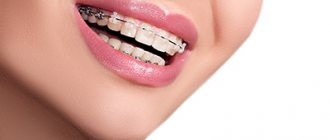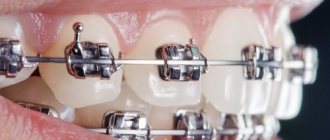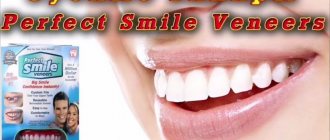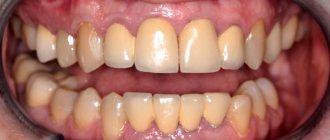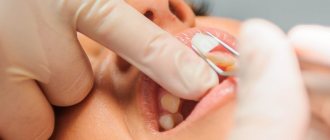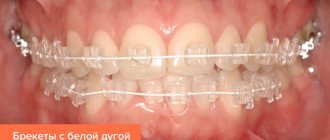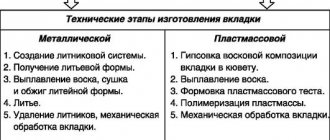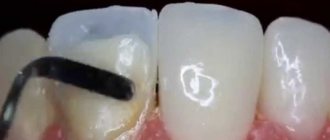An orthodontic positioner is a specialized functional device used in the final stages of correcting malocclusion. The materials used for the manufacture of this device are represented mainly by biocryl, durasoft, bioplast, PM-1 plastic - all of them have soft, bendable, elastic capabilities for changing shape and configuration.
Before removing braces, it is extremely important to assess the reaction of the dental-maxillary system to the removal of elastic arches, and also to ensure that the teeth are in a state of occlusion without assistance. They can help with this:
- Replacing rectangular arches with light ones;
- Using vertical elastic bands after removing braces;
- Using an orthodontic positioner.
Advantages and disadvantages
Among the main advantages of wearing an orthodontic positioner are:
- Earlier possibility of removing braces, in contrast to the installed light arch;
- Active gum massage.
The disadvantages, in turn, are considered:
- Long time for individual production of the device;
- High price;
- Strengthening the incisal overlap negatively affects the deep bite;
- Expanded teeth can return to their original position.
Duration of use
Whether a patient needs a dental positioner will be determined by the attending physician, since he is familiar with all the nuances of the patient’s therapy. Typically, such devices are recommended to be worn after the end of the treatment process. How do they wear?
- During the first 48 hours, the device should remain on the teeth as long as possible.
- When 2 days have passed, the patient switches to constant wearing technology. This means that the device is not removed at all at night, and during the day it is on the chewing organs for at least 4 hours.
- To consolidate the treatment, wearing the device is prescribed for at least 3 weeks. After this, the ego can be removed and used as a removable retention system.
It is important that immediately after removing the bite correction device, the device is ready. Before its installation, professional hygiene and enamel remineralization are carried out. The main thing is that the patient follows all the dentist’s instructions. This is the only way to achieve a good treatment effect. You should definitely visit the dentist twice every 12 months. This is necessary for sanitation of the oral cavity. Patients with problematic occlusion should periodically make appointments with orthodontists. This is necessary to regularly check units that have been adjusted.
How a positioner is manufactured and installed
Individual production of an orthodontic positioner should begin at least 1 month before the expected end of using braces. It is manufactured according to the following plan:
- Taking impressions of teeth that will be corrected;
- Making a plaster model;
- Placing teeth in the desired position;
- Removal of rings and braces;
- Closing and eliminating free space;
- Molding of rubber on models;
- Direct fit to the teeth and installation in the oral cavity.
Only a specialist who is initially involved in correcting the bite of a particular patient and who knows all the details and nuances of the process can determine whether it is necessary to use such a technique or not.
Indications for use
The scope of use of this device is not extensive, since it is less effective than other systems. The device is used:
- If there is an active process of inflammation of the mucous tissues after wearing devices to correct the bite.
- When patients are at high risk of developing open occlusion.
- If the device is recommended as a removable retainer.
With the help of the apparatus, the fangs and incisors move up to three millimeters in the oral direction. The design provides alveolar shortening of one millimeter, and in lateral units - up to two millimeters. The strip allows you to move the chewing organs of the upper jaw by no more than 2 millimeters, and on the lower jaw only by 1 mm. Transparency allows the dentist to identify those areas where compression of the mucous membrane and alveolar process occurs. In such cases, correction is carried out. As an independent therapy technology, this method is recommended for mild anomalies.
In modern orthodontics, ceramic structures and metal braces are most often used. The arc, that is, the power wire, is inserted into the slot hole. It is created from a titanium-nickel alloy. It is activated when it heats up in the patient's mouth, putting constant pressure on the units. This causes them to shift in a given direction. As a result of this impact, units move. The arc pressure is systematically adjusted by the dentist during the dentist's visit.
Positioner There are about 40 modifications of positioners, which depend on the size, shape of the jaws and teeth.
Standard positioners are made of soft polyurethane.
Positioners are very effective in restoring normal tissue tone and density in cases where gum hyperplasia develops.
Most often, positioners are used, so to speak, as finishing devices: at the adjustment stage for the final correction of the position of teeth, and also as retainers. Positioners are also used to correct minor tooth misalignments.
During the first weeks, the positioners are worn no more than 4-5 hours a day to get used to them. Later, most patients get used to the positioners and leave them even while sleeping.
Advantages of positioners:
- positioners simultaneously maintain the positions of the teeth inside and the occlusal relationships of the arch
- positioners are comfortable to wear (compared to individually manufactured two-jaw appliances)
- positioners don't break
- positioners are transparent
- positioners hold or change the position of teeth
- positioners stimulate tissue tone
Disadvantages of positioners:
- The positioner is large in size, which makes it difficult to wear it all the time at the beginning of treatment
- The positioner should be worn at all times so that it can secure the incisors against tilting and rotation.
- there is a possibility of teeth becoming loose due to muscle balance forces
- positioners are contraindicated in patients with nasal breathing problems
Cost of orthodontic treatment at DejaVu dentistry. ORTHODONTICS
| 11.1. | Diagnostics | |
| 11.1.1. | orthodontist consultation | 600 |
| 11.1.2. | monitoring the progress of treatment with a removable device (one visit) | 1100 |
| 11.1.3. | monitoring the progress of treatment with a non-removable metal device (one visit) | 1800 |
| 11.1.3.1 | monitoring the progress of treatment with a non-removable aesthetic device (one visit) | 2100 |
| 11.1.4. | one impression with alginate impression material | 300 |
| 11.1.5. | one impression with two-layer impression material | 500 |
| 11.1.6. | one dental plaster model | 300 |
| 11.1.7. | one model made of orthodontic plaster | 500 |
| 11.1.8. | analysis of one targeted Ro-image | 100 |
| 11.1.9. | calculation and analysis of one OPTG of jaws | 500 |
| 11.1.10. | calculation and analysis of one TRG of the head | 3000 |
| 11.1.11. | calculation and analysis of jaw models | 1500 |
| 11.1.12. | calculation and analysis of 3D models | 3000 |
| 11.1.13. | one photo of the face, teeth, etc. | 100 |
| 11.2. | Removable equipment | |
| 11.2.1. | trainer fitting | 9300 |
| 11.2.2. | mechanically operating apparatus manufacturing, fitting | 15000 |
| 11.2.3. | functional apparatus (Andresen, etc.) manufacturing, fitting | 25000 |
| 11.2.4. | functional guiding apparatus (FR - I, II, III, etc.) manufacturing, fitting | 32000 |
| 11.2.5. | elastopositioner manufacturing, fitting | 75000 |
| 11.2.6. | Invisioline mouthguard manufacturing, fitting | 5000 |
| 11.2.7. | mouthguard for remotherapy manufacturing, fitting | 10000 |
| 11.2.8. | protective mouthguard manufacturing, fitting | 12000 |
| 11.2.9. | restoration of the therapeutic functions of a removable device | 6000 |
| 11.2.10. | additional element to the removable device (Bertni screw, etc.) | 5000 |
| 11.3. | Fixed equipment | |
| 11.3.1. | fixation of one bracket (without bracket cost) | 2300 |
| 11.3.2. | fixation of metal braces on one row of teeth | 41000 |
| 11.3.3. | fixation of aesthetic braces on one row of teeth | 51000 |
| 11.3.4. | fixation of non-ligature braces on one row of teeth | 54000 |
| 11.3.5. | fixation of lingual braces on one row of teeth | 59500 |
| 11.3.6. | fixation of lingual braces on one row of teeth “INCOGNITO” | 170000 |
| 11.3.7. | fixation of the dental arch is simple with a metal device | 1900 |
| 11.3.7.1 | fixation of the dental arch is simple with an aesthetic apparatus | 2200 |
| 11.3.8. | fixation of a complex dental arch with the vestibular apparatus (with loops, etc.) | 2800 |
| 11.3.9. | formation of one bend on the dental arch | 1300 |
| 11.3.10. | formation of one loop on the dental arch | 1900 |
| 11.3.11. | formation of a complex arc (utility, etc.) | 6900 |
| 11.3.12. | fixing 1 additional non-removable element (button, tube, etc.) | 2100 |
| 11.3.13. | fixation of 1 additional removable element (spring, stopper, etc.) | 1950 |
| 11.3.14. | removing metal braces from one row of teeth | 4900 |
| 11.3.15. | removal of aesthetic braces from one row of teeth | 6900 |
| 11.3.16. | removal of lingual braces from one row of teeth | 7900 |
| 11.3.17. | installation of an individual retention device on one row of teeth (removable or fixed) | 15500 |
| 11.3.18. | removal of the retention apparatus from one row of teeth (cleaning, grinding and polishing of teeth) | 11000 |
| 11.3.18. | restoration of retention functions of one retainer | 4900 |
| 11.4. | Treatment using additional devices and devices | |
| 11.4.1. | grinding the cusps of one tooth | 200 |
| 11.4.2. | aproskimal separation of one tooth | 260 |
| 11.4.3. | facebow fitting | 18700 |
| 11.4.4. | fitting the lower lip bumper | 15600 |
| 11.4.5. | fitting of a non-removable simple dilation apparatus (quadhelix, etc.) | 18000 |
| 11.4.6. | fitting of a complex non-removable dilating apparatus (Derichsweiler, etc.) | 27000 |
| 11.4.7. | fitting of a non-removable extension device (first class, etc.) | 37000 |
| 11.4.8. | fitting of a non-removable functional apparatus (Herbst, etc.) | 37000 |
| 11.4.9. | fitting a simple face mask (chin sling, etc.) | 18000 |
| 11.4.10. | fitting a complex face mask (Tubinger, etc.) | 27000 |
| 11.4.11. | hygiene of one dentition after removal of the metal appliance | 4600 |
| 11.4.12. | hygiene of one dentition after removal of an aesthetic device | 5200 |
| 11.4.13. | hygiene of one dentition after removal of the lingual appliance | 5600 |
| 11.4.14. | remotherapy for one row of teeth | 2000 |
| 11.4.15. | installation of a mini-implant “VECTORTAS” | 18000 |
Orthodontic patients are treated by an orthodontist: Bednyakov Alexander Alexandrovich, more than 20 years of experience as an orthodontist
You can obtain more detailed information on orthodontic treatment in Innovative during your initial consultation at our dental clinic.
You can sign up for orthodontics in Moscow by calling: and orthodontics in Zhulebino
Note to parents
How the parents feel about the installation of a removable device determines how the child will feel about this procedure. Adults often make one unforgivable mistake - when they look at the design, surprise appears in their eyes and they ask the question: “How will my child wear this, much less get used to it?” It is clear that after such a reaction, not a single child will want to go to the orthodontist. Therefore, first of all, you need to set yourself up for a positive outcome - high treatment success. This way the child can get used to the device faster.
Removable devices - what are they?
Removable appliances can correct pathologies in the development of teeth and jaws. And they have been doing this for many years. The child grows, and such devices stimulate the natural processes that occur in the body. And you shouldn’t delay treatment, because the sooner it starts, the more effective it will be - this way you can achieve results faster.
The list of removable devices includes mouthguards and trainers. With their help, you can get rid of minor pathology - when there is no need to carry out complex procedures to correct the dentition. We will also highlight Hintz plates and positioners, which also belong to removable devices.
They can be used by people of all ages. Most often they are installed on children, since their jaw anomalies are reversible, therefore, the installation of corrective braces, which must be worn constantly, is not required. Also, such devices are used after serious procedures designed to correct the bite so that the dentition does not shift back.
Removable devices are divided into:
- Single jawed. A person must wear them around the clock, otherwise the treatment will not bring any results. You can take them off while eating, but it’s not necessary. You just need to rinse your mouth after eating so that no food remains remain.
- Double jawed. They must be used at least 12 hours a day during sleep and wear at home.
